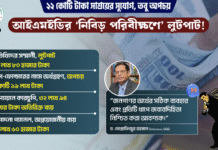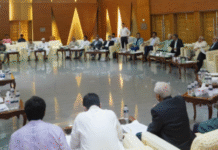By Julien Bouissou

SATKHIRA – In the district of Padmapukur, a few dozen kilometers from the Bay of Bengal, tin shacks balance delicately on scraps of land coming out of the sea, like makeshift boats lost in the middle of the ocean.
Only children, women, old people and the severly handicapped still live in the homes scattered along these dying rice paddies. In this region, which is subject to floods and cyclones, men have left to seek work elsewhere. There isn’t even enough wood to cook a loaf of bread. Traders on small boats laden with essential commodities come to supply the villagers.
In 2009, cyclone Aila killed a dozen people in the village. The inhabitants had to take refuge on the embankment, and waiting for months for the water to come down so they could rebuild their homes. In Padmapukur, they don’t even bother rebuilding brick houses. They make do with temporary walls made of corrugated iron.
Bangladesh is one of the countries most vulnerable to climate change. Two-thirds of the country is less than five meters above sea level. Rising water levels are already very noticeable in the islands along the Bay of Bengal, such as in Sagar or Kutubdia. Bangladesh accounts for 60% of the world’s cyclone victims in the past 20 years. According to the World Bank, up to eight million Bangladeshis may need to leave their homes by 2050.
For locals, the choice is simple: flee the south of the country or barricade themselves behind higher dikes. The Monwara family left its flood-ravaged village in 2007. They now live dozens of kilometers north of Padmapukur, in a small shack covered in branches, on a roadside. Raised a few meters, the roadsides here are very popular because they increase the chances of survival during flooding.
Begum, the mother, sells small sachets of shampoo to workers who pass by on their way to the brickyard. “I hope we will find my daughter a husband who lives far away from here, far away from the coast. And who will take care of her,” she confides. Around them, the salt water has already begun to eat at the land. Farmers are forced to sell their rice fields to entrepreneurs, who transform them into shrimp farms.
“These shrimp farms bring in money, but they are a curse for the poor. They require much less labor than rice paddies,” explains a man whose hands are damaged from working in the paddies. The men are forced to go further up north to find work in farms, or even to India. To cross the border illegally, all they need is to pay a smuggler five euros to take them across the river in the dark of night.
Just seeds
Southwestern Bangladesh is served by the small Jessore airport. While mechanics repair a twin propeller, the passengers, most of them NGO employees, talk about the fight against poverty, malnutrition and climate change. The region survives on international aid. Along the main roads, there aren’t any other signs than the metal panels nailed to wooden posts advertising the presence of major humanitarian organizations.
What else could advertising signs advertise? The region is so poor that they can’t afford to buy vegetables, only seeds to grow the vegetables themselves. They do not get paid with money, but with flour or rice. The distances are not measured in kilometers but in takas, the local currency. What sells best in the region are the metal trunks used to store personal belongings in case of flooding.
The population, which has been plagued by malnutrition and poverty, now faces the first consequences of climate change. The World Food Programme (WFP), in partnership with the Bangladeshi government, has implemented a program called “Enhanced Resilience,” which trains people – mostly women – to better cope with devastating floods and cyclones, and pays them to strengthen dikes. During two years, they receive a monthly income as well as food rations.
“The program is aimed primarily at women because, unlike their husbands, they cannot migrate,” said Christa Räder, WFP representative in Bangladesh. The third year, they receive aid to buy a goat, some chickens or to start a small business and not depend on agriculture alone. According to UN projections, Bangladesh could loose 40% of its agricultural lands through 2050.
Bangladesh is adapting its agriculture to climate change, working for instance on a variety of rice that is resistant to salt water and flooding. But they must also raise road levels; build dikes along 6000 kilometers of coast, clean the canals where there sediments have accumulated and set up cyclone shelters with food stocks. Alert systems must be developed, using mosques and especially mobile phones, which everyone here has.
Adapting to climate change already has a government fund of $189 million, established in 2009 with the assistance of the EU, Australian and American development agencies. But these funds may be insufficient. In a study published in Dec. 2011, the World Bank estimated that the costs associated with protecting infrastructures against floods could reach $3.3 billion in 2050.
Source: World Crunch









